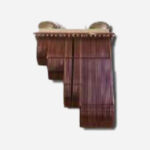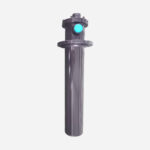The heat exchanger is a device that is less noticed by us, so many people don’t know about it, have never seen it, or even never heard of it. This is normal because it is not a common household appliance like air conditioners and refrigerators. It is very industrial. Today we share this ultimate guide to heat exchanger basics, read through it and I believe you will have a basic understanding of heat exchangers.
What is a heat exchanger?
We usually call heat exchangers by names such as heat exchangers and cooler. The simplest explanation is that the process of exchanging heat flow into cold flow by infusion or penetration of a cooling medium, under a specific process device, is a heat exchange
The vast majority of these are for industrial use, but there are also a few domestic heat exchangers.
We briefly say a few words about the home heat exchanger: it’s in addition to the size and style of different, in fact, and the northern collective heating heat exchanger principle is similar, there are also cast iron types, storage types, plate types,s and other classifications.
What are the types of heat exchangers?
Its job is to transfer heat from a hot fluid to a cold fluid. It is widely used in chemical, petroleum, compressor, energy, heat treatment, and other industrial sectors. According to the principle and way of heat exchange between hot and cold fluids, it is generally divided into three main types: Separate type, hybrid type, and heat storage type. (Separate type is the most, and we also mainly produce this type of heat exchanger).
Separate Type
The hot and cold fluids are not mixed, the structure is simple and can be installed and run on the outer wall of the vessel. Now the products are updated quickly. The previous inter-wall type does not have a high heat transfer coefficient, and in order to heat evenly, it needs to add an agitator or spiral spacer to increase turbulence to make up for the uneven heat transfer surface and accelerate cooling. We mainly produce:
- Bearing oil cooler (immersed coil type heat exchanger):
- stainless steel or purple copper light tube, or rolled fin tube bent into a circle (and the shape of the container fit), installed immersed in the liquid medium of the container for cooling.
- The structure is simple and can withstand high pressure. However, because of the slow turbulence of the liquid medium in the vessel, it is necessary to add an agitator to accelerate the flow to improve heat transfer.
- Air cooler (A heat exchanger that uses air to cool a hot fluid):
- The thermal fluid inside the tube is heat exchanged with the air outside the tube through the tube wall and fins, which is usually accompanied by a ventilation fan to accelerate the air operation.
- The use of air coolers can save a lot of water, reduce environmental pollution and lower costs. Especially in dry and water-scarce areas, air cooling is suitable instead of water cooling.
- Shell and tube cooler (tube cooler):
- It is the most widely used cooler and the style we do the most, and the number of tube sections can be increased or decreased as needed.
- The cavity inside the heat exchange includes the tube process (flow inside the tube), shell process (flow inside the shell), fins, and cooling tubes.
- There is a spiral tube bundle design that has greater turbulence and heat exchange efficiency and can be used in the food and pharmaceutical industries if it is made of stainless steel.
- Box cooler (insertion type, also cylindrical box cooler):
- the cooling tube is bent into a U-shaped, integrated U-shaped cooling tube bundle expansion to the tube plate.
- The fluid passes through the gap between the cooling tube and the cooling tube respectively, the flow rate is fast and the heat transfer coefficient is large.
- This box cooler has a special application area: ships. (There will be a separate article on marine box coolers)




Hybrid Type
Hot and cold fluids can be completely mixed and directly contacted for heat transfer. Avoid the heat transfer interval and dirt heat resistance on both sides to maximize the heat transfer rate. Industries include: having circulating water inside cooling towers, gas scrubber towers to cool gases, and steam condensation in condensers.
Heat Storage Type
Hot and cold fluids can be mixed and are often used in the metallurgical industry, such as in the heat storage chamber of steelmaking flat furnaces. This type of cooler has a solid filler inside to store heat, and the hot and cold gases will enter the accumulator at the same time to be heated.
What quality problems can occur with heat exchangers?
The most common is leakage. Leakage can cause water and chemical materials to mix, seriously affecting the quality of the product.
We can counter-check where the leakage occurs at the weld, whether it is due to water scouring, chemical corrosion, or its own quality.
After a leak occurs, we first need to check, then patch welding, experiment, and repair, and generally this takes a few days to complete. The latter also requires regular inspection and maintenance.
How much does it cost to buy a heat exchanger?
It depends on the drawing design and material selection. Materials are divided into steel, stainless steel, and copper. Cooling tubes are also available as bare tubes and various finned tubes.
The fins are made of aluminum fins, stainless steel fins, copper fins, and other materials. Others have special testing and certification, packaging methods. These are all factors that affect the price.
How do I install a heat exchanger?
We have had numerous installation experiences and never had installation problems. But the installation also needs to pay attention to the ground is level, some products directly have brackets flat on the ground, and some need to be fixed with expansion screws and the ground.
There are also heat exchangers and the ground to do horizontal alignment so that hot and cold fluids can flow properly and will not be unilateral pressure too high. Finally, there are firmly fixed brackets, some of which are suspended or inserted into the container.
How to test the performance of your heat exchanger?
Analyze whether the change law of the heat transfer coefficient when the water flow rate changes and the airflow rate changes meet the process requirements.
- First of all, you need to list the following data: air/water/oil inlet and outlet temperature, flow rate, differential pressure, heat balance error, and heat transfer coefficient.
- After fixing the hot water flow rate and changing the air flow rate, the test is performed. Then, in turn, fix the air flow rate, and change the hot water flow rate to do the test, each test to determine and record: inlet temperature, outlet temperature and flow rate, resistance, and other parameters.
How should your heat exchanger be cleaned and what are the chemicals to clean it?
It is not simply rinsing or brushing with water but needs to be operated by professionals. You can refer to the following methods, strictly record the time of each step during cleaning and check the cleaning effect.

- First, the heat exchanger is rinsed with flowing water to simply clean the internal mud and scale impurities, which can improve the acid-cleaning effect.
- Then the acid cleaning solution into the heat exchanger, static immersion waiting for 2 hours, and then a continuous dynamic cycle for 3-4 hours.
- During the period of alternately positive and negative cleaning every 30 minutes, after the end of acid cleaning, if the acid PH value> 2, the acid can be reused. Otherwise, the acid-washing solution will be diluted and neutralized and then reasonably discharged for environmental protection treatment.
- After the end of acid cleaning, use sodium hydroxide softened water configuration, using the dynamic cycle of a bad way to alkaline cleaning of heat exchangers, to achieve acid-base neutralization, which will slow down the later corrosion rate.
- After the end of the alkaline cleaning, use clean softened water, and then repeatedly rinse for 30 minutes to thoroughly rinse the residue inside the heat exchanger.
Do homes also need heat exchangers?



Needed, but we do not call it a heat exchanger, will be called a heater, radiator, or floor heating, living in northern homes with more. Or some new air systems need to use heat exchangers. Air conditioners are equipped with coolers.
What is the best heat exchanger?
There is no which heat exchanger is the best, only the most suitable and most matching heat exchanger for your equipment. If you are looking for the best supplier, then definitely our JED brand cooler supplier is the best, welcome to JED to buy your cooler.
This piece of article can be a complete overview of the basics of heat exchangers, need to know more expertise can contact us. We have been researching heat exchangers since 1998, professional team, and professional service, please leave your problems to the professionals to solve.


















